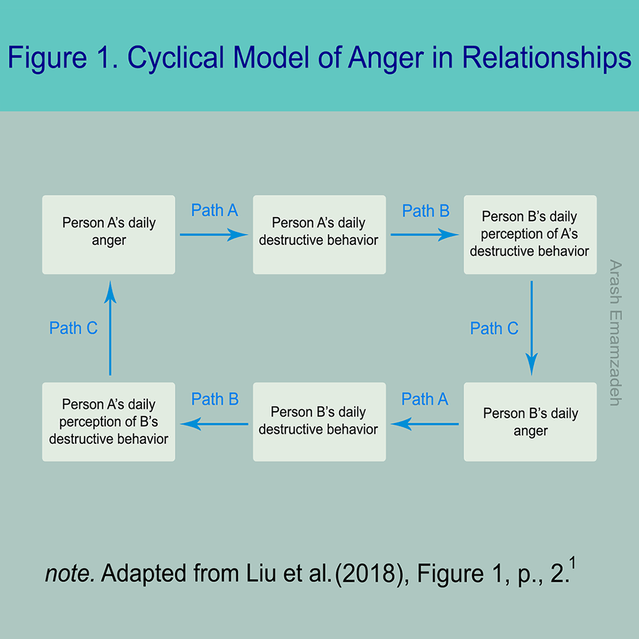I really like this article!!
Rory
__________________________________
https://www.psychologytoday.com/ca/blog/finding-new-home/201901/the-cycle-anger-in-relationships
by: Arash EmamzadehF
A new study examines a model of how anger is perpetuated in relationships.
Posted Jan 15, 2019SHARE
A new study by Liu et al., published in the December 2018 issue of the Journal of Research in Personality, examines such a model of cyclical anger in romantic partners. In this post, I describe the authors’ model, and summarize the findings of their empirical investigation. I end with suggestions to break the vicious cycle of angry feelings and damaging behavior in relationships.1
The Cycle of Anger in Relationships
According to the authors’ dyadic model of anger in relationships, being mistreated by one’s romantic partner evokes anger, and that anger can motivate reciprocation of the mistreatment, eventually resulting in a cycle of destructive behavior and rage.
Let us examine this model in more detail.

Source: Adapted from Liu et al., 2018 (Arash Emamzadeh)
As indicated by Path A (Figure 1, top left section), feelings of anger sometimes trigger destructive behaviors — critical, cold, and selfish behaviors. These behaviors differ from respectful and constructive criticism, which focuses on the issue and does not attack the individual. In contrast, destructive behaviors are experienced as disrespectful, hostile, demanding, invalidating, rejecting, or blaming.
To see how destructive behaviors might initiate the cycle of anger in romantic relationships, let us imagine the following scenario: Partner A and B have financial problems. One day, A comes home from work to find B drinking a very expensive alcoholic beverage. Furious, instead of giving B a chance to explain, A resorts to destructive behaviors (e.g., name-calling). See Figure 1, middle section, top rectangle.
At this juncture, what might fuel the cycle of anger is B’s accurate perception of A’s behavior. Is there a high likelihood that B will correctly perceive the destructiveness in A’s behavior? Yes. According to previous research, romantic partners are good at identifying each other’s conflict-related response styles. So B can easily tell whether A is being hostile or providing constructive criticism.
The cycle of anger usually continues down Path C (Figure 1, right side) because Person A’s antagonistic behavior, once correctly perceived by Person B, elicits B’s anger. It is natural that B should feel angry, because when people sense that others are being rejecting (instead of responsive and supportive), they feel indignant.
Note that this path we have been following — from A to B to C — could be initiated by the other partner too (Figure 1, starting from the bottom right corner and moving left). Just as Partner A’s anger can result in A behaving destructively, Partner B’s anger might also motivate B to behave in a destructive manner.
Therefore, the cycle can be set in motion from different points. But the results might be the same: perpetuating the cycle of destructive behavior and anger, and intensifying negative emotions and abusive actions — perhaps to a point where neither partner recalls the initial source of anger which set this destructive cycle of rage in motion.

Source: Josethestoryteller/Pixabay/Arash Emamzadeh (modifications)
An Empirical Test of the Cycle of Anger
The present research tested this cycle of anger empirically. The sample consisted of 96 heterosexual couples who were undergraduates at a U.S. university (average age of 23 years; 79 percent Caucasian; 82 percent dating, 14 percent married).
Participants completed intake measures and daily questionnaires for a week. The daily questionnaires measured participants’ experiences of anger, destructive behaviors (e.g., being selfish, insulting, cold) toward their romantic partners, and perceptions of their partners’ destructive behaviors. Also assessed was the personality trait of agreeableness (related to being trusting, cooperative, and friendly).
Analysis of the data was performed using multi-level modeling. All three hypotheses of the researchers were supported: Partner A’s daily anger toward Partner B predicted A’s destructive behaviors toward B; A’s destructive behaviors toward B predicted B’s perceptions of destructive behaviors; and B’s perception of A’s destructive actions predicted B’s anger.
Relationship commitment did not influence the results. Trait agreeableness did affect the results, but only when the level of anger expressed was low.
Agreeableness was associated with a reduced tendency to engage in antagonistic behavior, treating partners with less antagonism, and lastly, participants feeling less angry when their misbehaving partners were highly agreeable.
How Do You Break the Cycle of Anger?
You can disrupt the self-perpetuating cycle of destruction and anger between you and your romantic partner by weakening the links under influence. How?
For one, if you reappraise your partner’s behavior more positively, you might weaken the link between your perception of the behavior and the resultant feelings of anger inside you.
For example, when you find your romantic partner drinking an expensive beverage, you could reframe the drinking as an exception to the many ways your partner has been contributing and helping you cut costs. In this mindset, you can still discuss the drink, but you will be much less likely to resort to insults, threats, and other harmful behavior. Why? Because you will be less angry. Compare this mindset with thinking, “You are drinking that out of spite!”
Additionally, it is helpful to activate friendly thoughts — thoughts related to support, kindness, and compromise, not rejection or retaliation. That is what people high in agreeableness do instinctively.2
And when you are ready to express your anger, do so in a more constructive manner. Even when you do not feel enraged, you may be unintentionally angering your partner by using profanities or using words like never, always, worst, etc. In contrast, by expressing your anger more constructively and focusing on your own feelings, you are less likely to provoke your partner and fuel or initiate the vicious cycle.1
In conclusion, the cycle of anger may be broken at several points. This requires at least one of the two partners to act mindfully and refuse to participate in the cycle of destructive behavior.
When neither partner is mindful, the cycle of anger might be perpetuated, harming both romantic partners and their relationship — sometimes irreversibly. So, if you struggle with controlling your anger, consider learninganger-management techniques, and if your anger is out of control, consider seeing a therapist.
Facebook Image Credit: MilanMarkovic78/Shutterstock